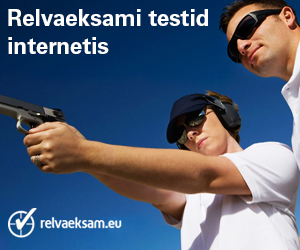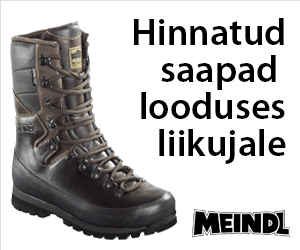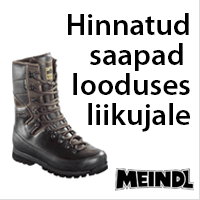Welcome to the home page of the Estonian Hunters’ Society!
CONTACT INFORMATION | ESTONIAN HUNTERS’ SOCIETY | INTRODUCTION | HUNTING REGULATIONS FOR FOREIGN CITIZENS | APPLYING FOR THE DOCUMENTS | HUNTING SEASON | HUNTING BAG/STATISTICS | MAGAZINE ESTONIAN HUNTER | INTERESTING FACTS | GENERAL INFORMATION | AFRICAN SWINE FEVER |
 Contact information:
Contact information:
Address: Kuristiku 7, 10127 Tallinn
Phone: +372 602 5970
E-mail: ejs@ejs.ee
We are open on weekdays from 10.00-18.00.
The Estonian Hunters’ Society
The first known hunting organizations were founded in 1869 in Pärnu. The adoption of the Hunting law in 1934 was the crucial moment in the development of Estonia’s hunting. The number of hunting organizations increased continuously and in 1967 the Estonian Hunters’ Society (EHS) was created. Now the EHS is the biggest organisation in Estonia that unites hunters and most of the 15 000 hunters are our members.
The EHS is a member of the C.I.C (the biggest organization that unites hunters from all over the world) since 1994 and a member of FACE (unites the hunting organisations of the European Union) since 1991. Since 1997, Estonia is a member of FITASC (globally coordinates skeet shooting, gives the right to participate in European and World Championships).
What is FACE? Read about it HERE.
The Estonian Hunters’ Society:
- Organises events regarding hunting, the most popular of which are annual hunters’ summer days with almost 5000 participants.
- helps do develop hunting shooting, photo shooting and other sports relevant to hunting
- hosts hunting guests and organises hunting tourism
- helps to develop the activities of member organisations and creates hunting related interest and speciality associations
- participates in developing laws regarding hunting
- participates in nature conservation activities and arranges bucolicism.
- gathers information about hunting and distributes it through its magazines, of which the Estonian Hunter comes out periodically
- participates in research concerning hunting
- evolves co-operation between the state and local self-governments
- represents Estonian hunters internationally.
We have three annual events: Epiphany (3 kings day), hunters reunion festival in the summer and non-hunting days in Christmas (from 24th to 26th of December).
Hunters´ summer reunion festival
Hunters reunion event has usually been held in different regions of Estonia and the local hunting clubs help to organise it. The event has diferent features every year depending on the characteristic features of the region. In 2019 there were about 6000 people, hunter with the families etc together.
Usually the event relies on three different activities. There is sport competitions (hunting related), training/educational lectures & entertainment. On the spot of the event there will also be a little fair (different local hunting traders and some from Baltic region as well).
All the information is on our website (in estonian): https://www.ejs.ee/kokkutulekud/
Introduction
Estonia is a unique hunting land. Huge forest massives have preserved here. The forest covers about a half of our territory. Our game fauna is versatile and rich. A lot of game that are allowed to be hunted here, are forbidden or extinct in Europe, for example the bear, wolf, lynx, beaver and elk. The Estonians may also be called a wild fowl nation, because half of our border is the sea and in addition to that we have thousands of lakes.
The hunting here is based on the collective hunt principle. Hunting clubs have the right to hunt. The minimal hunting district according to the law has to be at least 5,000 hectares. The average hunting territory is about 10,000 hectares. The big game is hunted on the principle: one license – one game. The owner of the hunting territory has the right to validate the prices of the licenses. The average age of the hunters is relatively high like in other European countries, over 50 years.
There is no doubt that every hunter, who visits Estonia, finds something interesting both in the hunting and culture.
Welcome to Estonia!
Read more about hunting in Estonia HERE.
BEST PRACTICES OF ESTONIAN HUNTING
Hunting regulations for foreigners in Estonia
About 3,000-4,000 foreign hunters visit Estonia every year.
The Estonian legislation states that a member of a foreign country may hunt in Estonia, if he/she has a valid hunting license of Estonia or a country acknowledged by Estonia and who has a permit to hunt in the given hunting territory.
EHS gives out a temporary certificate for foreigners. A member of EU may bring his/her own weapon to Estonia, if he/she has an EU weapon passport issued by his/her own country’s respective institution.
In the case of big game hunt Estonia accepts foreign hunters’ big game shooting test granted to him/her in the previous 2 years or he/she has to pass the test in Estonia.
Hunting Act (in force)
Applying for the documents
If you want to come hunting in Estonia, you can apply for the documents from the Estonian Hunters’ Society or the person who invited you can apply for you. It takes up to 10 work days. Please plan ahead!
You can apply and receive the documents on Mondays, Tuesdays and Fridays from 10 am to 5 pm.
The Estonian hunting license is valid up to one year and you have to have your original hunting licence with you as well.
To apply:
- The fee for the hunting license is 20 euros, the fee for big game shooting test 3 euros.
- Send the form and copies to kristel@ejs.ee (she can also help you, if you have problems filling in the form etc).
- Add a copy of your big game shooting test (only if you are planning to hunt big game)
- Add a copy of your hunting licence
- Fill in the form (you can find the form https://www.ejs.ee/blanketid/)
- Application to get an Estonian hunting license and/or a big game shooting test for a foreign citizen
- Certificate for the completion of training (water fowl hunting) ENG (PDF), ENG (DOC)
- Contract for the use of immovable(s) for hunting (DOC)
Renewing the license
If you have previously applied for the hunting license and have space/free slots at the back of the card, you can renew the license!
- You have to fill in the application again and bring copies of your valid hunting documents.
- The fee for renewing is 20 euros for the hunting license and 3 euros for the big game shooting test.
Hunting fee
A hunting licence means an individual’s right to hunt and is subject to that person possessing documents which prove their right to hunt and having paid the hunting fee. The fee is charged for one year, i.e. 365 days. More information about the fee HERE.
Get a better view of the hunting season by clicking on the image or from our information pamphlet HERE.
Hunting statistics/hunting bag
A summary of the hunting bag from hunting seasons :
- 2022/2023 hunting season (PDF)
- 2021/22 hunting season (PDF)
- 2020/21 hunting season (PDF)
- 2019/20 hunting season (PDF)
- 2018/2019 hunting season (PDF) (XLS)
- 2017/2018 hunting season
- 2016/2017 hunting season
- 2010/2011-2015/2016 hunting season HERE.
Magazine Estonian Hunter
We have our own magazine “Estonian Hunter” (Eesti Jahimees) that comes out 6 times a year (February, April, June, August, October and December). The circulation is 11 500 and goes straight to the homes of our members. Till 2000 it was in newspaper form, but since 2001 we have issued it as a magazine.
It is possible to order the magazine to foreign countries from Omniva.
If you are interested in advertising in our magazine, the information is HERE.
For further information: jahimees@ejs.ee
Interesting facts
- Average Estonian hunter is 40‒60 years old and huntress is 26‒40 years old.
- Around 3000‒4000 foreign hunters come to hunt in Estonia every year.
- Brown bear is the biggest predator of the Estonian forests. Brown bear can weigh 90‒340 kg.
- Beaver is one of the biggest rodents in Estonia. This indigenous animal was extinct in the 19th century due to over hunting, but reappeared in 1957. Now it has spread countrywide, even to the islands. Beaver is also causing huge damages in the forest and field.
- Wild boars first appeared in Estonia in the 1920s. The weight of wild boars caught in Estonia ranges 50‒150 kg. The biggest bagged boar weighed 350 kg, the biggest sow 300 kg. Since 2014 the African swine fever spread in Estonia and since then the population have drastically decreased.
- Lynx is the only local wild cat in Estonia. Its average weight is 20–25 kg.
- Elk, the most majestic wild animal of our forests, has been the most valued species of game in Estonia through ages. Bulls weighing more than half a tonne have been bagged in here.
- The most feared predator in the Estonian forests is wolf. The biggest wolf caught, weighed over 80 kg.
General information
The area of Estonia is 45,227 km2, the population is 1,34 million and the average density of population is 31 people per square kilometre. The length of the coastline together with more than 1,500 islands is 3,794 km. Islands make up 9,2% of the entire area, the largest ones are Saaremaa, Hiiumaa, Muhumaa and Vormsi.
There are more than a thousand lakes in Estonia, the largest of which, Lake Peipus, is one of the biggest in Europe. Estonia is a coastal country with an average altitude of only 50 meters. The height of the biggest hill, Suur Munamägi, is only 318 metres above the sea level. Forests cover 48% of the territory, i.e. 2,04 million hectares, swamps and mires cover 20%. The area suitable for hunting amounts to 4,1 million hectares. The main species of game include elk, wild boar, roe deer, red deer, beaver, lynx, bear and wolf.
African Swine Fever (ASF)
African swine fever is a highly contagious viral disease affecting pigs, including domestic pigs and wild boar. It is characterised by high fever, haemorrhages, inflammatory changes in organs and a high mortality rate (up to 100%).
Other animal species or humans are not susceptible to African swine fever, but they can transmit the virus. African swine fever can cause significant economic damage, including job loss, to the pig farming sector.
The first case of African swine fever among Estonia’s wild boar population was confirmed on 8 September 2014 when African swine fever was diagnosed in a wild boar found deceased in Hummuli, Valga County. Earlier in 2014, several cases of African swine fever were diagnosed in Latvia, Lithuania and Poland.
On 21 July 2015, Estonia’s Veterinary and Food Board confirmed the country’s first case of African swine fever among domestic pigs.
Summary about the information (in English, courtesy of the Veterinary and Food Board).
As of 12.10.2016 the disease has been found in all the mainland counties and on our biggest island Saaremaa.
The latest updates can be found www.seakatk.ee (in Estonian and Russian), also links to websites in other languages. Some pages: European Comission map, African swine fever (US Center for Food Security and Public Health), Pigprogress news.
Map of the surveillance zones in Estonia (data from 4th of July 2018). Grey lines – municipality borders. Blue area – Part I zone, light red area – Part II zone.


































